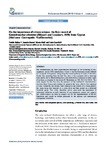On the importance of citizen-science: the first record of Goniobranchus obsoletus (Rüppell & Leuckart, 1830) from Cyprus (Mollusca: Gastropoda: Nudibranchia)
| dc.contributor.author | Kleitou, Periklis | |
| dc.contributor.author | Giovos, I | |
| dc.contributor.author | Wolf, W | |
| dc.contributor.author | Crocetta, F | |
| dc.date.accessioned | 2019-04-16T16:14:14Z | |
| dc.date.issued | 2019-04-04 | |
| dc.identifier.issn | 2242-1300 | |
| dc.identifier.issn | 2242-1300 | |
| dc.identifier.uri | http://hdl.handle.net/10026.1/13720 | |
| dc.description.abstract |
The Mediterranean Sea faces unprecedented challenges by the increasing of non-indigenous species (NIS) introductions. Cyprus is the first European country affected by Lessepsian immigration, being along the natural pathway of many of the Indo-Pacific taxa spreading from the Red Sea; thus, it has a pioneer role in detecting alien species and in demonstrating that a concerted action is necessary at early stages of invasion, as required by the recent EU Regulation on NIS (EC/1143/2014). The present study reports for the first time Goniobranchus obsoletus from Cyprus and confirms the spread of the species in the basin, after its first sightings in Israel. Moreover, the records were collected in the context of a citizen project, this taxon being first detected by a scuba diver and then posted on a dedicated Facebook group. This study, therefore, proves once more the importance of technology utilization in early detection of non-indigenous species and suggests that citizen-science can form an integral tool for the implementation of the EU Regulation and should be further promoted by the national and international management authorities. | |
| dc.format.extent | 252-257 | |
| dc.language.iso | en | |
| dc.publisher | Regional Euro-Asian Biological Invasions Centre | |
| dc.subject | Non-indigenous species | |
| dc.subject | Alien spreading | |
| dc.subject | Levantine Sea | |
| dc.subject | Suez Canal | |
| dc.subject | Red Sea | |
| dc.title | On the importance of citizen-science: the first record of Goniobranchus obsoletus (Rüppell & Leuckart, 1830) from Cyprus (Mollusca: Gastropoda: Nudibranchia) | |
| dc.type | journal-article | |
| dc.type | Journal Article | |
| plymouth.author-url | https://www.webofscience.com/api/gateway?GWVersion=2&SrcApp=PARTNER_APP&SrcAuth=LinksAMR&KeyUT=WOS:000467774800006&DestLinkType=FullRecord&DestApp=ALL_WOS&UsrCustomerID=11bb513d99f797142bcfeffcc58ea008 | |
| plymouth.issue | 2 | |
| plymouth.volume | 8 | |
| plymouth.publication-status | Published online | |
| plymouth.journal | BioInvasions Records | |
| dc.identifier.doi | 10.3391/bir.2019.8.2.06 | |
| plymouth.organisational-group | /Plymouth | |
| plymouth.organisational-group | /Plymouth/Faculty of Science and Engineering | |
| plymouth.organisational-group | /Plymouth/Faculty of Science and Engineering/School of Biological and Marine Sciences | |
| plymouth.organisational-group | /Plymouth/Users by role | |
| plymouth.organisational-group | /Plymouth/Users by role/Academics | |
| dcterms.dateAccepted | 2019-02-13 | |
| dc.rights.embargodate | 2019-5-1 | |
| dc.identifier.eissn | 2242-1300 | |
| dc.rights.embargoperiod | Not known | |
| rioxxterms.versionofrecord | 10.3391/bir.2019.8.2.06 | |
| rioxxterms.licenseref.uri | http://www.rioxx.net/licenses/all-rights-reserved | |
| rioxxterms.licenseref.startdate | 2019-04-04 | |
| rioxxterms.type | Journal Article/Review |


